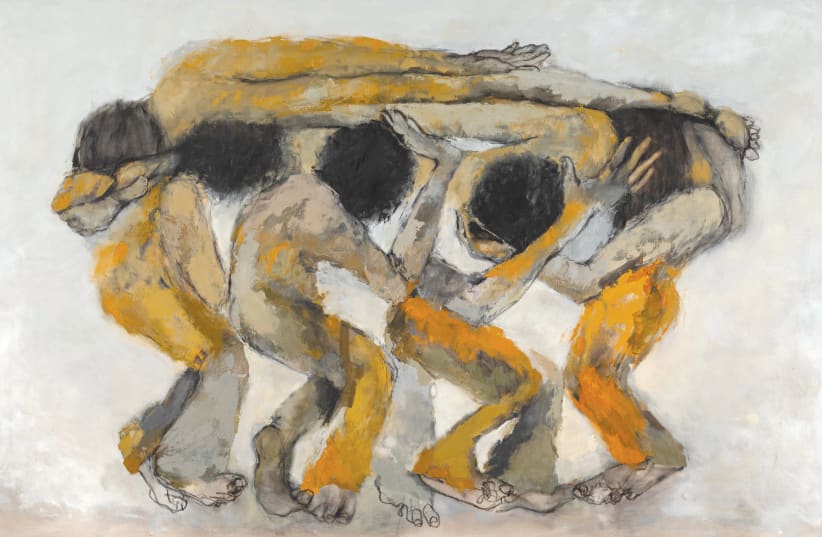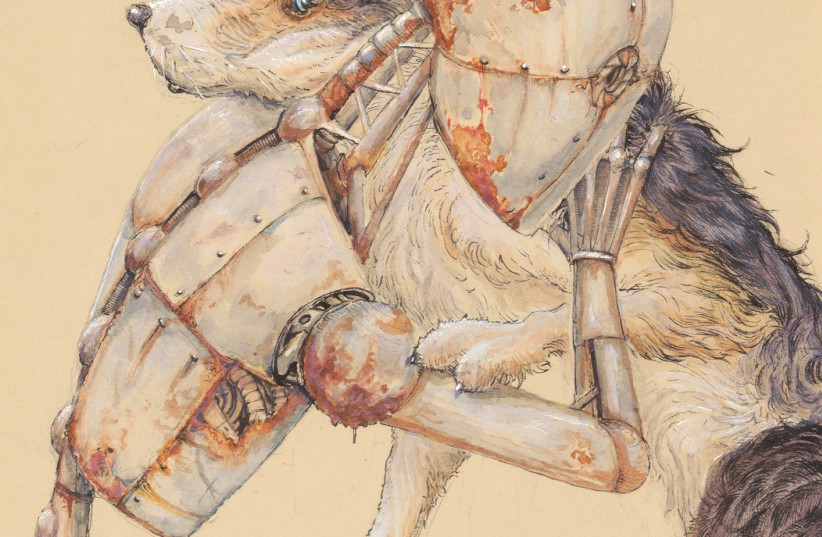A special exhibition spotlighting the response of Israel’s arts community to the war that began on October 7, and the burst of creativity witnessed since the surprise Hamas attack, will open at Tel Aviv’s ANU Museum of the Jewish People on Friday, February 23.
For Dan Tadmor, CEO of the museum, the October 7th special exhibition is a very ambitious undertaking. The museum, he said, “planned, collected, and created displays of artistic expression from the past four months” following the deadly Hamas attack – a “seminal event” in the history of the Jewish people – that exacted an unprecedented deadly toll, particularly on unarmed civilians of all ages who lived near Gaza.
Noted ANU’s chief curator, Dr. Orit Shaham Gover: “As the canons are heard, the voices of the muses are emerging all the more clearly from deep down in the throat. [This exhibition is] not a summary of anything. This is not a retrospective. We have no way to analyze and look back at this horrible event because it has yet to end.”
Instead, it is “a snapshot of the current situation and the way Israeli culture has reacted to the horrors of October 7 and the war afterward,” added Gover.
For an Israeli population still processing trauma, the ANU October 7th exhibit might well be a form of art therapy.
Tadmor and the museum’s team of co-curators, including Carmit Blumensohn and Michal Houminer, realized from social media that what happened in this wartime period was something very unique. Usually, artists respond and react to wars years later, with important creations such as books, films, or music. In Israel, on the day the war started, artists woke up and started working, detailing their emotions and reactions to what was happening.
“Even in the midst of Israel’s war against Hamas in Gaza, we are experiencing an abundance of creativity in all fields of art,” Gover observed.
ANU’s OCTOBER 7th exhibition has three main elements: expressive art, music, and documentary art, and brings together the works of 25 Israeli artists. Visitors will tour the exhibit as a soundtrack plays throughout.
Victims of Hamas massacre will have work featured at exhibit
The exhibiting artists include some who were taken hostage or murdered in October, as well as residents of southern Israel, who along with their families experienced the loss, destruction, and pain of war.
“Visitors will see suffering in the form of video art and will also see the internal conflict of graphics of a beating, bleeding heart,” said co-curator Houminer.
The special ANU exhibit is “very personal” said co-curator Blumensohn, “because in such a small country, the impact [of the October 7 attack has affected] every home.
“We have seen a tremendous explosion of creativity to express emotions in depth. What’s happening now highlights that artists are very sensitive people,” she added.
In the field of music, “a very unusual phenomenon happened,” noted chief curator Gover. “In past Israeli wars, musicians usually performed in front of soldiers. Their appearances were well organized by the army. Since October 7, however, without any organization and without any call from the public, Israeli musicians performed voluntarily, everywhere.
“They performed at funerals, in hospitals, and for evacuees. In many cases, since government institutions were slow to react, musicians were the first people survivors saw after running away from their houses. In this respect, this musical community reacted the way music should react as a form of consolation. The deepest meaning of music is consolation,” she said.
Within a few weeks of the October 7 attacks, ANU installed a special lobby display, such as a ceiling-to-floor, 20-foot-long graffiti wall featuring the work of Inbar Haiman, known in the international graffiti artist community as Pink. The awful and tragic story of Inbar’s fate didn’t become apparent until mid-December when the IDF confirmed that Inbar had been violently abducted trying to escape from the Supernova music festival at Re’im. She was murdered in Gaza, and her body is still held hostage. Her work is also part of the new October 7th exhibit.
“Inbar treated her art as a means of messaging her philosophy and values to the world. She believed we must accept anyone no matter how different he or she may appear,” said Eli Cohen, Inbar’s uncle.
“She believed that goodness must prevail and must be cultivated for a better world. She wanted to spread her love and care to the world. Inbar felt connected to nature and believed in better angels and spirituality. We are very excited and gratified that Inbar’s art is recognized and honored by everyone.”
The same could be said of all the artists whose work is on display at ANU’s special October 7th exhibition, which will remain as a permanent exhibition after March 2024.
For more information, visit www.anumuseum.org.il

